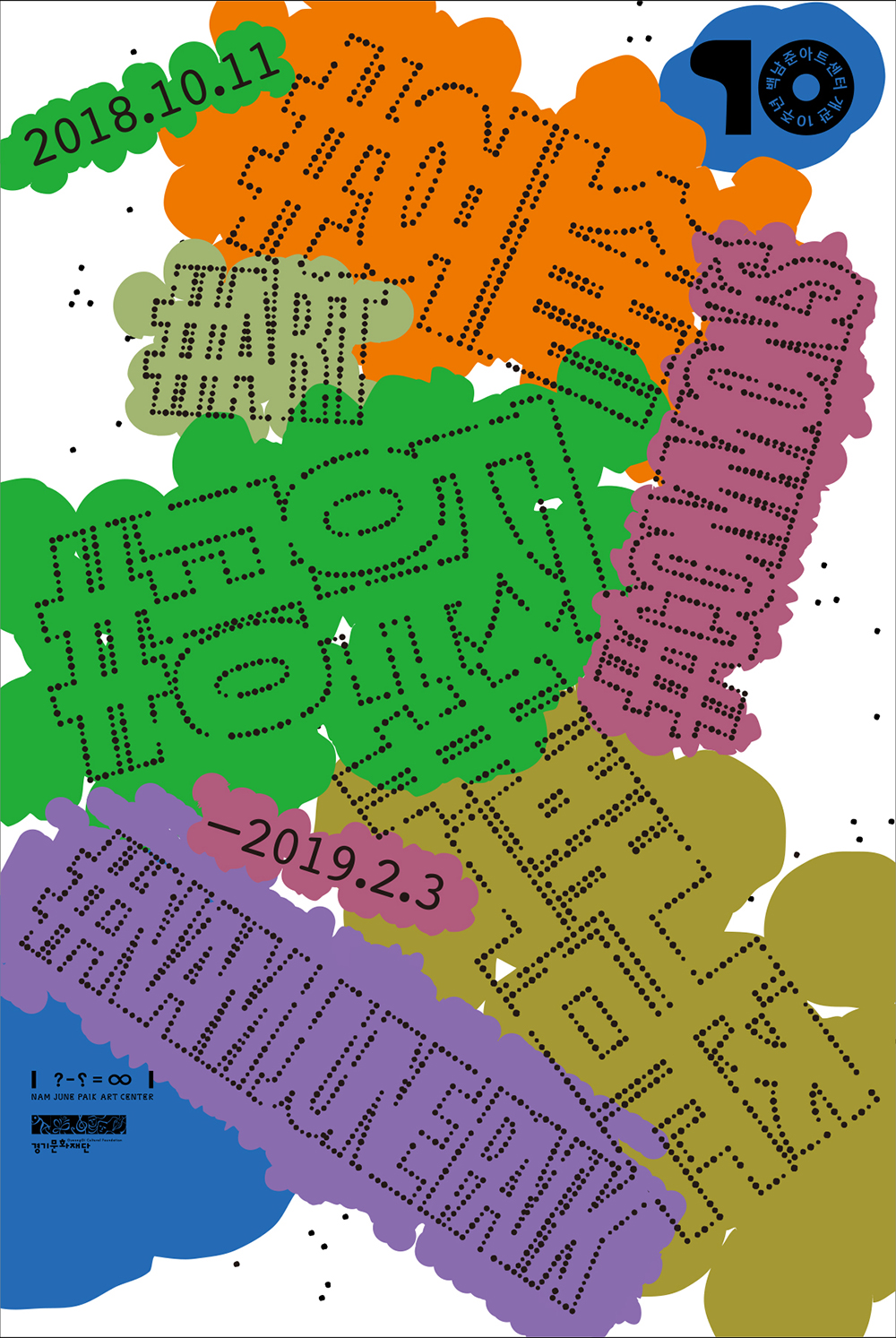Nam June Paik Art Center 10th Anniversary Commemorative Exhibition #Art #Commons #NamJunePaik
Period/ 2018.10.11(Thu) ~ 2019.02.03(Sun)
Venue/ Nam June Paik Art Center 1F, 2F
■ Overview
Exhibition Title
#Art #Commons #NamJunePaik
Period
2018.10.11-2019.2.03
Venue
Nam June Paik Art Center 1F, 2F
Opening
11 October, 2018 4pm
Artists
Hwayeon Nam, Dappertutto Studio, Rimini Protokoll, Bahc Yiso, Nam June Paik, Blast Theory, Ahn Kyuchul, Unmake Lab × Data Union Collective, Okin Collective, Joseph Beuys, Jeoung Jae choul, Part-time Suite, Heman Chong
■ Introduction
Commemorating the 10th anniversary, the NJP Art Center will experiment the feasibility of museum as the commons based on the motto, “Art Commons, Nam June Paik” along with the works of artists who continue to ruminate the new ontology and communication method of art. This exhibition tracks the subversive thinking of Paik who believed “art is not private property” and saw Video art as the commons. It will introduce the pioneering ideas of Paik who left his intellectual property accessible to everyone with works including Video Commune, which experimented his dream of “video common market” through the interactive exchange of video worldwide, and the Paik-Ave Video Synthesizer, which experimented the interactive exchange among media and the intervention of the artist and audience. Furthermore, this exhibition will also showcase the ideas of other pioneering artists whom proposed novel ontology of art such as Joseph Beuys, who believed “everyone is artist”, saw life itself as art and sought the possibility of political revolution within the arts.
The artists participating in #Art #Commons #NamJunePaik well represent the identity and direction of the NJP Art Center’s past ten years and they have been part of the museum’s previous exhibitions, performances, and education programs. For this exhibition, Ahn Kyuchul, Okin Collective, Dappertutto studio, Unmake Lab × Data Union Collective, and Jeoung Jae choul will showcase new projects based on the concept of the ‘Commons’. Hwayeon Nam’s Imjingawa excavates the collective memory discovered while tracking the orally passed down community song. Rimini Protokoll’s 100% City series is performed by the 100 residents from certain city, and they represent the statistical composition of population, gender, goods and environment of that city. For this exhibition, Protokoll will present two different video performance series, 100% Gwangju and 100% Amsterdam. Jeoung Jae choul will introduce works that crossover the ‘tragedy’ and ‘hope’ found in the commons, employing the cultural anthropology report on the garbage patch found in the ocean, which is the commons for the entire humanity. Additionally, Bahc Yiso, Blast Theory, Part-time Suite, and Heman Chong will exhibit the scene of common goods shared by humanity, the interaction between local community and audience, and further express the ethical, political issue found in city development and the usage of the commons within the city.
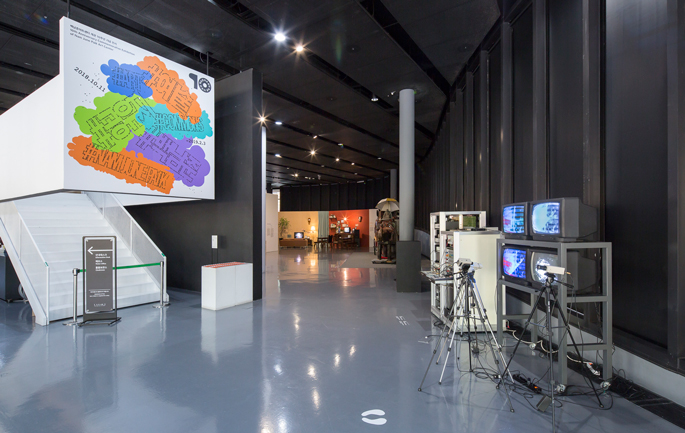
■ #NJPAC #10years #Archive
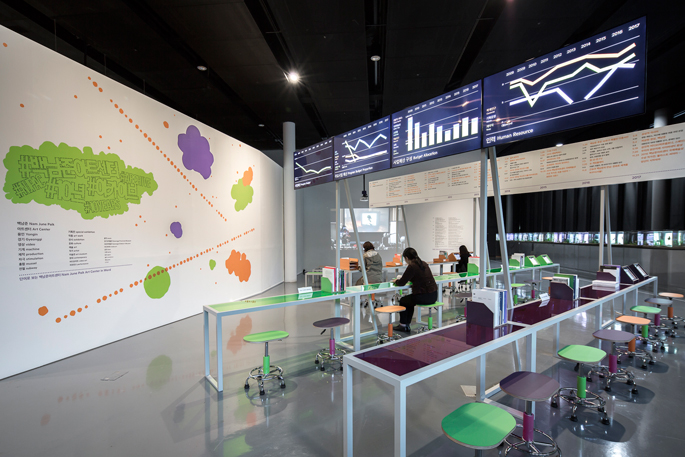
Along with #Art #Commons #NamJunePaik, a separate archive exhibition, #NJPAC #10Years #Archive will be presented on the first floor of the NJP Art Center. This section will exhibit various words that represent the ten years of the NJP Art Center along with statistical analysis, photographs, graphics and published materials of the previous exhibitions, education programs and other public programs curated by the NJP Art Center. This archive exhibition will also provide a section for viewing audiovisual performances and to space to search information about the NJP Art Center. The visitors could experience the ten years of this museum by way of the nonlinear and organic arrangement of the archival materials. #NJPAC #10Years #Archive will be the grounds to witness the rapid change in the topography of Korean contemporary art’s past ten years through the digital and analogue records housed in the NJP Art Center.
■ Participating Artists and works
1-1. Nam June Paik, Fluxus Island in Décollage Ocean, 1964, print on paper, Nam June Paik Art Center archive
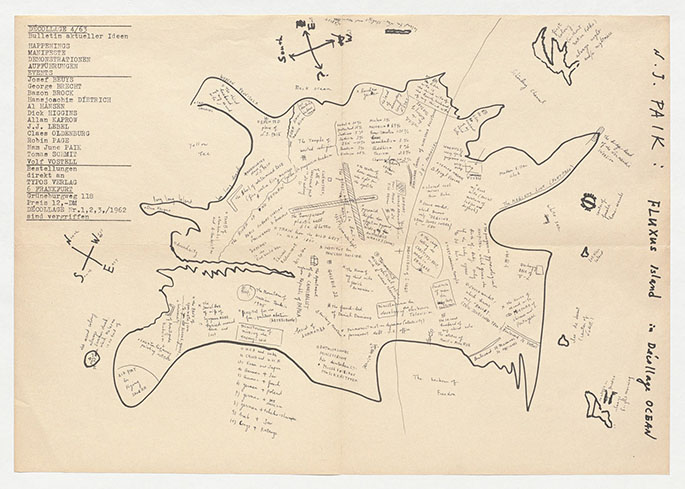
Fluxus means ‘flowing’ in Latin and it also signifies an artist collective based in Europe and other parts of the world during the 1960s. Fluxus artists created an intimate community that shared everything from works of art to conditions of llife, and their work and life based on this friendship could be seen as certain model of the art commons. Fluxus was against the privatization and commercialization of art and this has influenced many artists including Nam June Paik.
Paik produced Fluxus Island in Décollage Ocean in 1964 and this was a supplement poster for the 4th issue of Décollage, a Fluxus magazine created by Wolf Vostell. Paik drew the Fluxus Island similar to the European continent and wrote phrases, “Ministerium of mixing the enemy race,” “Tomb of atom bombs and a-bomb victims” and etc. This work well represents the aesthetics of the Fluxus, which combines the interracial sensibility with humor and concise expression based on in-depth perception and criticism towards the society. The Learning Machine Kit exhibited along with this work is an educational tool kit for practicing games and drawings, and it was created by artists who participated in the The Learning Machine(2013) exhibition at the Nam June Paik Art Center.
1-2. Nam June Paik, Beuys Vox, 1961-1988, mixed media

Beuys Vox was produced to honor Joseph Beuys after his death and it reflects the in-depth relationship between Nam June Paik and Joseph Beuys. Apparent from the title, ‘Beuys’ voice,’ this work is composed with different voices of Beuys. It also includes their photograph at the Zero group exhibition in 1961 when the two were just acquaintances, a memo ‘Josef’ written in Paik’s book (1962), the photograph of 24 Hours performance in 1965 by the two artists, and the photograph and vinyl of their joint performance, In Memorium George Macinaus: Klavierduett.
1-3. Nam June Paik, Paik-Abe Video Synthesizer, 1969/1972, device for video editing and synthesizing
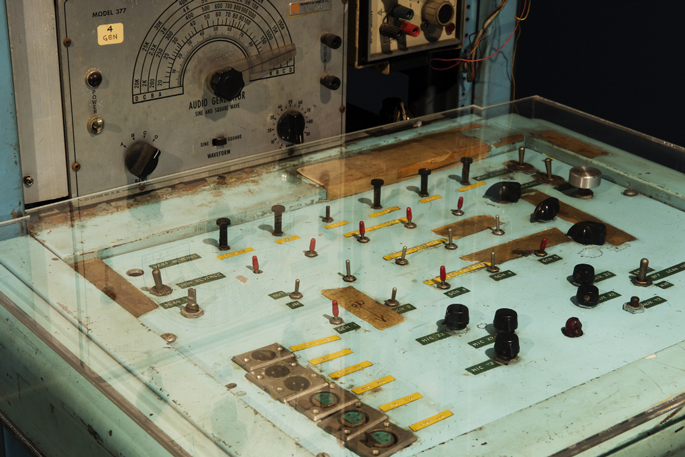
As it can be inferred from title ‘Paik-Abe,’ Paik-Abe Video Synthesizer is a collaborative work between Nam June Paik and a technician, Shuya Abe. Paik unveiled the technical components of the video synthesizer in hopes that people could use video as personal artistic tool like a piano. The Paik-Abe Video Synthesizer is a machine capable of transforming colors and shapes of videos transmitted live from external sources or camera, and it was used to produce Video Commune, which aired on WGBH Boston in 1970 and Media Shuttle – New York/Moscow on WNET New York in 1977.
In 2011, the Nam June Paik Art Center restored the functions of the synthesizer through the ‘Paik-Abe Video Synthesizer Restoration Project’ in collaboration with Shuya Abe. For this exhibition, the restored video synthesizer and the four monitors are installed in the form of combining video synthesizer and participation TV, similar to Paik’s 3rd solo exhibition at Galleria Bonino New York in 1974. And this would capture the audience and distort the video with abstract patterns using the video synthesizer. John Hanhardt critiqued that this work is in extension of Paik’s Fluxus strategy of breaking down the barrier between the viewer and the artwork by having the sculpture’s potential activated by the viewer.
1-4. Nam June Paik, Elephant Cart, 1999-2001, mixed media
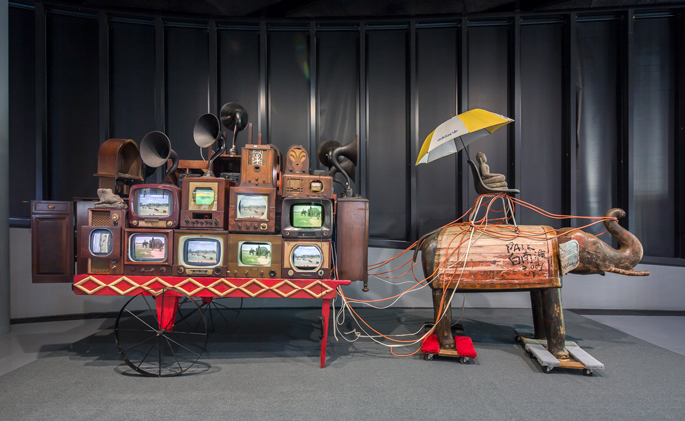
Elephant Cart is a work that holds ‘memory of media’ that Nam June Paik mentioned. Paik placed as many telecommunication equipment he could remember including antique television sets, radios, telephones, gramophones, speakers on a large cart led by the stone Buddha. Paik put the newly released television at the time, inside the case of an antique television to make it look old. The cart fully loaded with television and radio appears as if the information is proliferated according to the movement of the elephant composed with cable wires or the development of technology. The history, memory and experience of such media are certain kinds of cultural and historical commons that the entire human race should share. Paik desired to share this memory with everyone through his work, and this collective memory further extends our understanding and imagination of the media and media literacy.
1-5. Nam June Paik, Good Morning Mr. Orwell Paris/New York Live, 1984, 1channel video, 57min 21sec
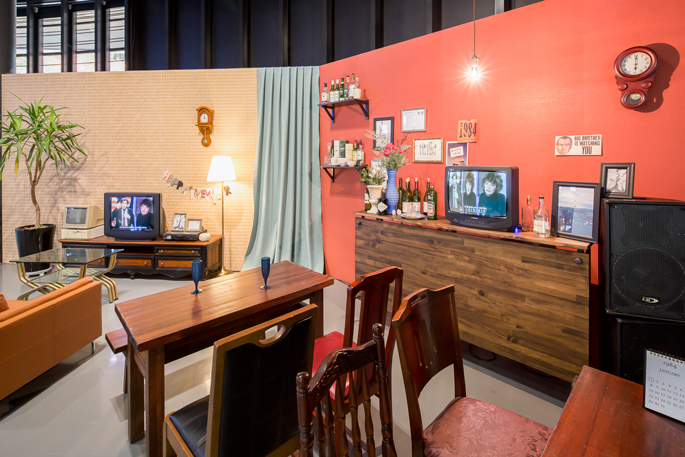
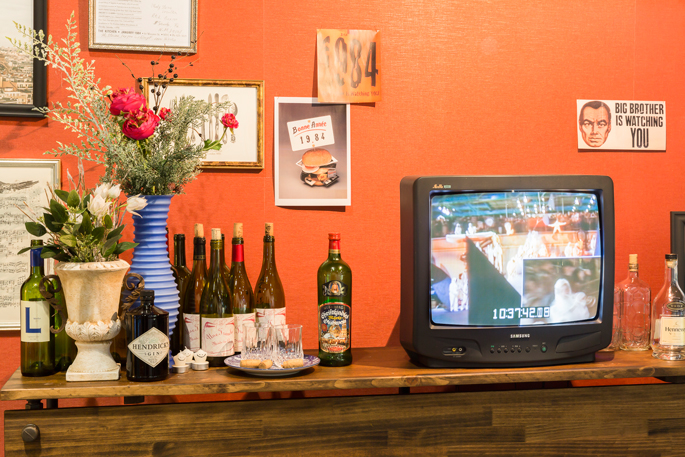
In opposition to the forecast of a totalitarian society where Big Brother would centralize knowledge and authority by use of television in George Orwell’s 1984, Nam June Paik conducted a live broadcast of his satellite project, Good Morning Mr. Orwell all over the world as he connected New York and Paris in real-time. This was edited in a way to transpose or juxtapose the performances of John Cage and Charlotte Moorman in New York and Joseph Beuys and Urban Sax at the Pompidou Centre in one frame. The satellite during the 1980s was the product of the Cold War and the fruit of high technology invested with exorbitant amount of national capital. As a result, this technology was only accessible to few major broadcasts and the NASA. However, Paik thought of these satellite broadcast system as an opportunity to bridge different continents and culture, thereby realized a true art commons where people could globally communicate through arts and culture.
2-1. Joseph Beuys, The Hamburg Blackboard, 1975, chalk on two panels

Jospeh Beuys completed The Hamburg Blackboard during 1974-1975 as he taught the winter session at the Academy of Fine Arts in Hamburg Kunstakademie, Germany as a visiting professor. The two panels each describe the psychological and physical evolution and energy movement. The keywords life, combination, language, energy with the drawings of human body, deer, hammer shape, lump of fat and etc. display a complete representation of Beuys’ thinking system.
2-2. Joseph Beuys, Coyote III, 1984, 1 channel video, 1hr 1min 20sec

When Joseph Beuys first arrived in the U.S. in 1974, he covered himself in felted cloth and rode an ambulance to Rene Block Gallery in New York to spend three days with a wild coyote only depending on a cane and felt, and then he returned to Germany. In this performance titled, I like America and America likes Me, Beuys attempted to live in coexistence with the nature to represent the primeval history and vitality of the Native Americans.
Coyote III is the very last collaboration between Paik and Beuys and it is a performance video of their concert held at the Sogetsu Hall in Japan on June 2nd, 1984. There are two grand pianos installed across from one another on stage and on the other side stands Beuys’ blackboard full of descriptions. Beuys holds the microphone and expresses an alternating ego from coyote to an artist, craving life and freedom, and Paik quietly performs Japanese pop music on piano with occasional improvised variations. The collaboration between these two artists create a powerful sphere of energy based upon sincere understanding of each other.
3-1. Rimini Protokoll, 100% Gwangju, 2014, video/audio installation, 1hr 40min

Helgard Haug, Stefan Kaegi and Daniel Wetzel form a team of author-directors since 2000. At the focus of their work is the continuous development of the tools of the art to allow unusual perspectives on our reality.
‘100% City’ has been performed already 32 cities in the world that vibrantly tackles issues of statistics, challenging traditional spatial, cultural, and political divides that inform how populations of people are represented and understood. The videos feature documentation from different performances that have happened around the globe, in which 100 everyday citizens of a particular city perform alternative demographies on stage, telling their stories and expressing their views on a broad range of topics, including aging, welfare, migration, and relationships.
Only 1% of Gwangju’s population has a non-Korean passport, 6% are over 70 years and 10% between 0 – 10 years of age. 51% of the Gwangjuans are women and 3% migrated from the Korean region Jeollanam-do. Spreading throughout the city over five months, 100% Gwangju began with the casting of one member who had to recruit another in 24 hours, who then recruited another and so on — all according to specific criteria of age, gender, household type, geography and ethnicity mirroring the demographic make-up of Korea’s 6th biggest city.
100% Gwangju — a gathering that is a city, a group just beginning to experience itself, a choir that has never practiced, an impossible entity with many faces — assembled into ever-changing new group pictures. Could this statistics truly represent the city of Gwangju and their citizens and the identity of their collective history?
3-2. Rimini Protokoll, 100% Amsterdam, 2014, video/audio installation, 1hr 49min © Chad Bilyeu
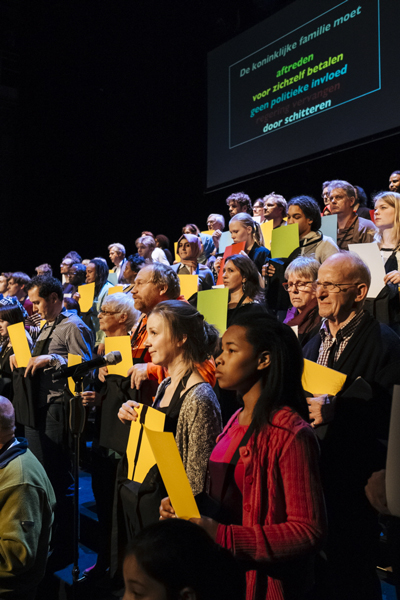
51% of the population in Amsterdam is female, 12% is over 65 years, whereas there are 4% in the age of 0-4 years. 230,549 of the 809,892 inhabitants of the city are singles, 69,857 are married with children…
In line with the other ‘100% City’ projects, this work also has 100 inhabitants in Amsterdam. This work was created in the same year as 100% Gwangju and it presents contrasting experiences of each city’s identity and community with the citizens and statistical data that represent Gwangju, the Northeast Asian city and Amsterdam, an historical global harbor city. Amsterdam consists of inhabitants from various nations and ethnicities from Turkey, Morocco, Africa and Asia. People who agree and disagree on forcibly occupying the city (squatting) politically voice their opinion at once. The citizens rotate in intersection and union on the issue of politics, environment, immigrants and etc. Witnessing how the citizens who just opposed to one another move to the same side, we learn that the identity of a community cannot be represented by one position
4-1. Part-time Suite, Wait for Me in a Crashing Airship, 2016, 360° VR video, sound, 16min 45sec, ⓒ 2016 Part-time Suite, SeMA Biennale Mediacity Seoul 2016 Commission

Part-time Suite was formed on the basis of a critical discussion on the common social-economic situation the members shared, and they have been placing emphasis on art and society within the plot of city landscape and space. They appropriate the limits and conditions of the current situation as interesting elements, employ the amplifying methodology of interference and initiation while presenting a rough but poetic performance, video, installation and etc.
Wait for Me in a Crashing Airship is a continuous gesture of someone in distress in the abandoned and forgotten space of the city. The movement of people in this work thickly embodies the emotion of despair and the Korean society’s spiritlessness and despondency in 2016 when this work was produced. The ‘Yeouido Bunker,’ which is assumed to be built by the military regime, plays a major role in this work. Their long interest and exploration of the abandoned, useless space ironically connects to the discovery and transition to artistic use of the ‘Yeouido Bunker,’ a once secretive space for violent politics. The bunker is cross-edited with the scenes of the abandoned spaces in the city such as a construction site and goshiwon (accommodations for students studying for exams), and the spaceship like that of the flying object in science fictions, casts a shadow unto the virtual city-like Yeouido. This striking contrast between the ground and underground floors provide an amplified sensory experience to the audience who is bound to the VR machine, floating around the virtual threedimensional space of distortion.
4-2. Part-time Suite, The Ballad of Real Estates 1, 2015, 2 channel HD video, sound & object installation, belt and keys, 23min 21sec, ⓒ 2016 Part-time Suite
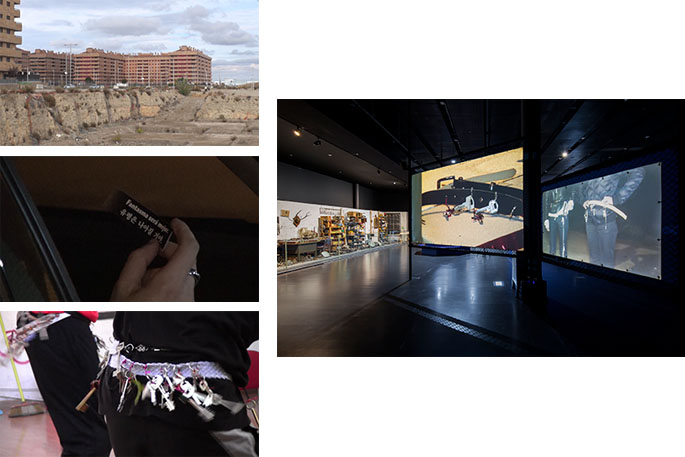
Part-time Suite encounters buildings abandoned in the outskirts of the city while visiting different cities in Spain. There are many bleak houses standing here and there without owners. These houses stand on the streets without any renovation, and some buildings are built halfway with steel frame sticking out while some have the cube shape but nothing inside. These are lump of contradictions resulted from the ceaseless persuasion of capitalism towards the private property of real estate. With this, Part-time Suite sees the “connotation of social antagonism surrounding the implication of private property and blatant economic calculation.”
The places that they visited are spaces for the community autonomously made within the “ruin of money.” However, it is considered illegal to use the private property for various communities so the artists couldn’t film this commons without limitations. This moment of transformation and the careful filming of sharing the useless, abandoned space as the commons with neighbors reveal the space as a “metaphor for joy.” The Ballad of Real Estates plays in this moment of joy as the possibility of sharing the city commons is slowly making its appearance.
5. Hwayeon Nam, Imjingawa, 2017, 1 channel video, 24min 16sec

Hwayeon Nam has been studying the movement and phenomenon of various objects operating in sync with the social system, and the structure and nature of time, expressed with exclusive possession of the body. She also unveils collective emotion and sensibility existing in the pile of memories accumulated by time through the work of tracking a discovered archive.
Imjingawa project began as Nam discovered a Korean word in a Japanese song she listened online out of coincidence. She couldn’t help but sings along this pitiful, mellow song and she follows the memory of people who sang this song. Imjingawa was composed as a Japanese song by Matsuyama Takeshi as he remembered the song, Imjingang he listened to at a Korean school in Kyoto. Matsuyama thought this song was a folk song and introduced it to the Kyoto based folk band, the Crusaders. The Imjingawa sung by the Crusaders earned great fame in the local provinces. However in 1968, the General Association of Korean residents in Japan makes a copyright complaint to the Toshiba Records that this song is not a Japanese folk song, but a North Korean song composed by Jonghwan Koh and lyrics written by a North Korean poet, Seyoung Park. The sale of this album was suspended afterwards and it was also banned from broadcasts, and this actually drew more attention and fame as a result.
Tracing the time/space where Imjingawa was first sung together, and the process of this song being disseminated by people who heard it and sung in different ways, Nam discovered the time in which this common ‘song’ was shared and inherited. This one ‘song’ sung with an original significance of the division between South and North Korea, sung in the guerrilla folk concerts full of the reform movement spirit in 1968, and also sung in different parts of the demonstration movements in Korea, is engraved as collective memory within time and each individual.
6. Dappertutto Studio, Dappertutto Studio, 2018, installation & performance
, Nam June Paik Art Center Commission

‘Dappertutto’ is an Italian word for ‘everywhere’ and Dappertutto Studio signifies an omnipresent studio, a studio that exists everywhere. Dappertutto Studio advocates this experimental identity as they produce works that inspect theatrical elements through projects that take the major conditions of a play such as drama, theater, actor, audience and experiment them as genre with the playwright taking the central role. An ordinary play has hierarchical composition with the division of labor among playwright, director, stage setting, acting, and audience, but these conditions voice their opinions in coexistence within the commons of a theater or direction in the play directed by a playwright. In this way, Dappertutto Studio compromises and listens to variety of voices and also accepts an undecided state and dissent at times. A play that gives up the way everything is decided and owned by the director, not only unfolds the play on theater stage but also everyday places and exhibition spaces, and further extends to the Dappertutto Studio beyond time and space.
This play with an identical title, Dappertutto Studio is an attempt of experimenting the form of playwright and play based on fame and profit. ‘Fame and profit’ is based on the eight Chinese characters given to men according to the birth time and they read a person’s disposition, temperament and even destiny.
Dappertutto Studio focuses on Nam June Paik’s fortune and its change, and unravels this as a process of a play together with the audience.
7. Jeoung Jae Choul, Another Part of Kraken, 2018, installation & video, mixed media, Nam June Paik Art Center Commission
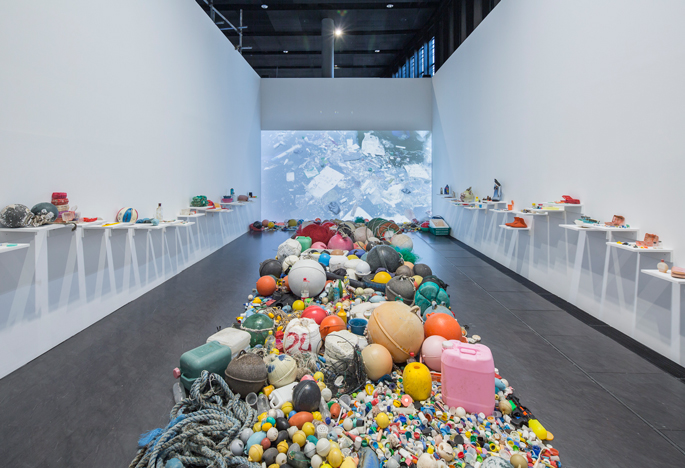
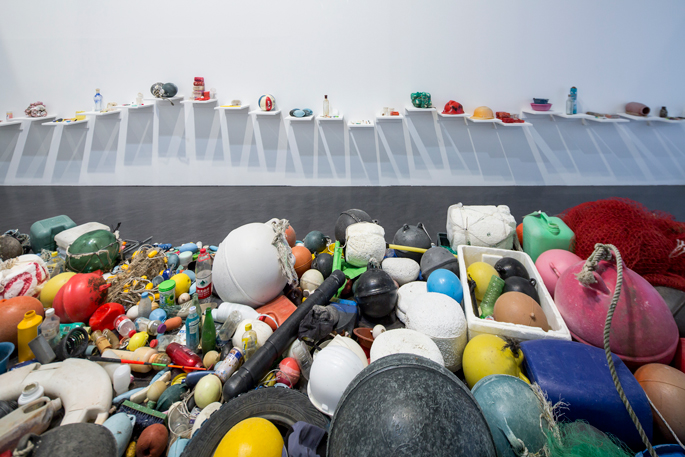
Jeoung Jae Choul has been working on the Silk Road Project since 2004, and he is researching and conducting participatory work on marine pollution and ocean wastes. His on-site practices excavate the memory of space and location, reveals cultural metastasis and combination, and reflects upon the issues of life while sympathizing with the nature.
The Blue Ocean Project arranged from 2013 recognizes the severity of marine pollution and ocean wastes, and aims to seek method on how art should deal with this issue. The current issue of ocean wastes is not just a problem for local residents in the seashore neighbor, but a global problem that harms the circulation structure of the environment. What role could art play in this tragic situation of the global commons where the ocean commons is being polluted? Another part of Kraken refers to the ocean wastes as a virtual ocean monster, ‘Kraken.’ While working on this project, Jeoung witnessed the numerous wastes floating around the ocean, attacking and polluting the ocean like a monster.
He has been seeking ways to relate art and reality as he raised awareness by drawing a topographic map of this marine wastes, excavated and documented a specimen of these objects floating in the ocean. For this exhibition, Jeoung collected and recorded the wastes floating around Jeju Island and the coasts of Shinan. Through this work that questions how the artist’s approach on environmental issue would bring sympathy and awakening, we will be able to observe art accusing the tragedy of the commons of ocean and arousing sympathy at the same time.
8. Ahn Kyuchul, There are things in the world that cannot be spoken in words
, 2018, sound installation & sculpture, wood, mixed media, 360×360×90cm, Nam June Paik Art Center Commission

Ahn Kyuchul has established his own world that connects art and narrative structure using various media such as conceptual object, architectural installation art, performance video and etc. For his recent projects, Ahn is constantly encouraging the audience to write, speak and document this into spatial poetry that consecutively holds the era.
There are things in the world that cannot be spoken in words installs a structure that appropriates the form of a ‘sound mirror,’ a wiretapping equipment constructed in the Southern coastal region by the British army to monitor Germany’s air raid ahead of time during World War II. At a fixed distance from this structure installed in the exhibition space, the audience would attentively listen to the various recorded phrases coming from the speakers on the opposite wall. From the ‘sound mirror,’ we experience the reflection of various sounds collected by our ears. We may also have a time of meditation and reflection as we listen to the aphoristic phrases on individual and society, and the relationship between myself and the world. Ahn requests the audience to write after they listen. One phrase that lingers inside the mouth, prayer, and whisper to gather and become a river of loud cry. And he also requests us to take these words somewhere as this river of phrases led us here.
9. Bahc Yiso, Today, 2001/2018, cut out wall in exhibition space, tube and coupler scaffolding, four projectors, four video cameras, woods
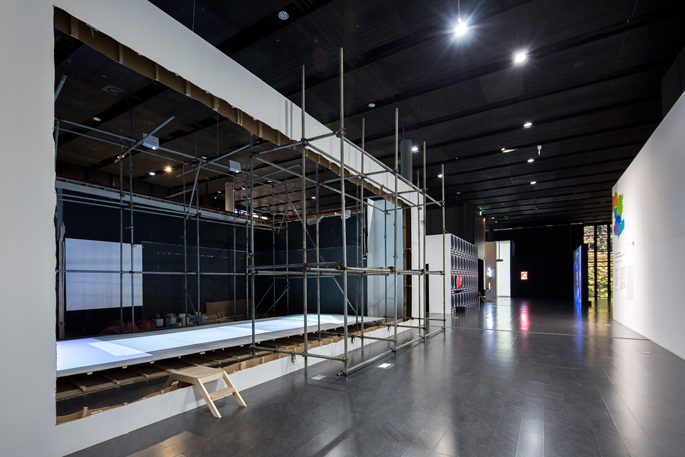

Bahc Yiso(1957-2004) was an artist, educator, alternative space director, activist and an art critic who lived and worked in the U.S. and Korea from 1990s to early 2000s. Bahc believed that an artwork was not solely created by the artist but produced in interaction with the surroundings, and also valued the possibility of multiple solutions for pending issues. Hence he also believed free, uncertain and obscure reciprocating motion between boundaries could become a work itself.
Today is an installation where part of a broken wall lay on the ground with a projection of sky upon this wall. Four video cameras are installed on the roof of the Nam June Paik Art Center towards the east and west sky to capture the movement of the sun, and this is projected on the laying wall in real-time. The image of a sun gradually moves from one end of the wall to another end all day. The media used in Today are lumbers from parts of a broken wall, architectural scaffold and etc. and these represent elements of architecture and destruction by placing dividers and materials from the construction sites, revealing the difference in reality and used image. As Bahc mentioned before, “rather than functioning in order with the given role, disorder and chaos, discontinuity and coincidence, broken casualty, and vague meaning takes large part not only in everyday lives but also in the realm of creativity and arts.”
10. Okin Collective, The More, The Better (Da-Da-Ik-Seon), 2018, 1 channel video, full HD, sound, Nam June Paik Art Center Commission

Okin Collective is an artist collective formed by Yi Joungmin, Kim Hwayong, and Jin Shiu, and they named themselves after the Okin Apartment complex (Jongno-gu, Seoul) where they presented their inaugural project. Okin Collective initiated from a specific site, but their activities are largely related to the various issues within our society. They approach the relationship of art and society in the means of promise and exchange, and interference to transform it into a sphere of amusement with self-reflection.
Okin Collective produced a video work with a theme of how to perceive the deformation and aging of an artwork as the Nam June Paik Art Center greets its 10th anniversary. Like the words of Nam June Paik, “art is not private property,” Okin Collective also believes that an artwork should find its own destiny although it is created by an artist. The More, The Better is a large-scale video installation of Paik installed in the National Museum of Modern and Contemporary Art, Korea. In 2018, The More, The Better discontinued screening due to deterioration and safety issues, and the discussion on its conservation and restoration has been extended to the citizens who enjoyed this work beyond the professionals in art world. Okin Collective explores the factors that decide the lifetime of work of a certain artist. In addition, they would examine works of art that resist or adapt to time and the diverse opinions of people who try to conserve the work, and present an opportunity for public discussion of art as the commons and the lifetime of an artwork.
11. Heman Chong, I Want To Believe, 2016, digital file freely distributed on the internet dimensions and materials adaptable per site

Heman Chong is an artist, curator and writer working in Singapore and New York and his works are in the intersection of image, performance, situations and writing. Chong’s works dismantle the way people act in everyday lives, and continuously questions the formation and function of the narrative happening within this. The existence of individual and group imagining the future, and the study on philosophical concept and basis takes critical part of his practice.
Chong paid attention to Chris Carter (Writer of The X-Files)’s interview with the Smithsonian where Carter mentioned the poster. Carter revealed that the original idea was to “place the spaceship and put the text ‘I Want To Believe’ in the style of Ed Ruscha.” Chong was inspired by this and he replaced the UFO with a dark blackhole and distributed them online for free, creating a new version of ‘I Want to Believe.’ This work is accessible for everyone to download the high resolution photograph and it could be printed in any material or size. People who download this image or coincidently encounter this poster on the streets or gallery can create some type of temporary community that shares a virtual belief. This image mediates the creation of a temporary community but the usage and interpretation of this image are undecided. The file can be downloaded from this link
goo.gl/V5s24u

12. Unmake Lab × Data Union Collective, Making Data Union
, 2018, light panel poster, website, SNS, Nam June Paik Art Center Commission

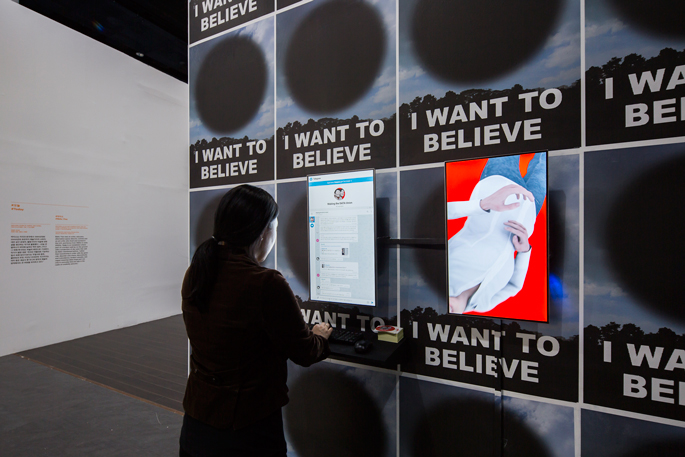
Unmake Lab researches the formation of interactive relationship among men, technology, nature and the society or the structure fixed among these, and places emphasis on the relocation of these as exhibition, education and study. Unmake Lab also presents alternative education program and research to get a hold of the change in technology society and the things being left out or distorted in this.
Their project, Making Data Union is also a question on the possibility of a new solidarity within the exhibition keyword the commons and its building process. The artists imagine a ‘data union’ solidarity with awareness that the production and trend of ‘data,’ with convertible capability in the information technology society, is becoming a major power that changes the society. They set up a chatting room to imagine and discuss the possibility of this union, and produce an open-call promotional poster to draw people’s participation. Unmake Lab × Data Union Collective will be the moderator of this round table, providing relative information and questions, and the unpredictable conversation will be published in a magazine. This imagination of a new union armed with each other’s data and information, leads to another imagination where science fictionlike resistance occurs against the privatization of online commons in the era where the capital collects, manages, controls and analyzes data created by an individual.
www.dataunion.kr

13. Blast Theory, Branch, 2015, a set of cards and playing instructions which can be downloaded and adapted from the website, 1 hour minimum playing time
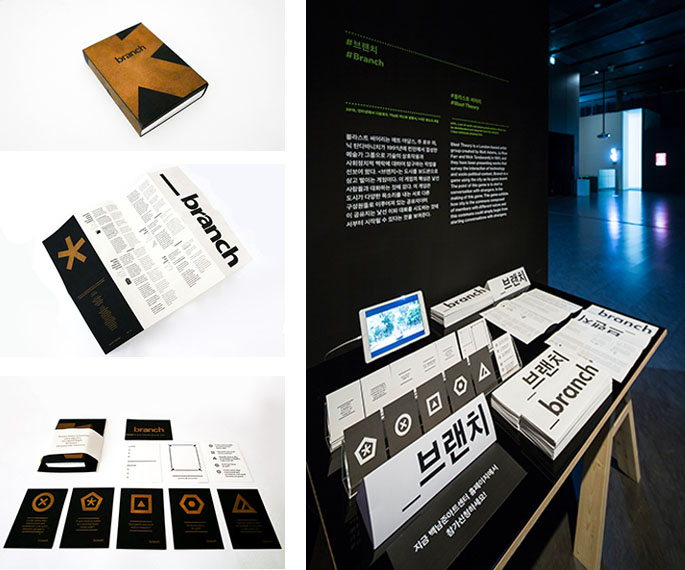
Blast Theory is a London-based artist group created by Matt Adams, Ju Row Farr and Nick Tandavanitj in 1991, and they have been presenting works that survey the interaction of technology and socio-political context. Their early works were based on clubbing culture that drew audience into the performance with radical and striking experiments, but since the late 1990s they expanded the range making various collaborative projects with many internet or technology-related research centers. Employing various media from theater, radio, game to the web, Blast Theory transcends artistic genres and continues to challenge themselves with groundbreaking practices such as digital real-time broadcasts and placing audience in the center of a real-time performance.
Branch is a game using the city as its game board. The players of the game each receive a map and series of question cards. The players have to discover various stores near the Nam June Paik Art Center and ask the correct question from the question cards after they exchange conversations with the neighboring residents. Players receive the Branch card when they ask the correct question and the team with the most Branch card wins this game, but the point of this game is to start a conversation with strangers. In the making of this game, Blast Theory met with people from different fields such as game design, semiology, advertisement, journalism, area/city study, and design to create a “system by and for people who never voice their thoughts.” This game exhibits how city is the commons composed of members with different voices, and this commons could simply begin from starting conversations with strangers.
Comments [0]
Leave a comment
You must be logged in to post a comment.















